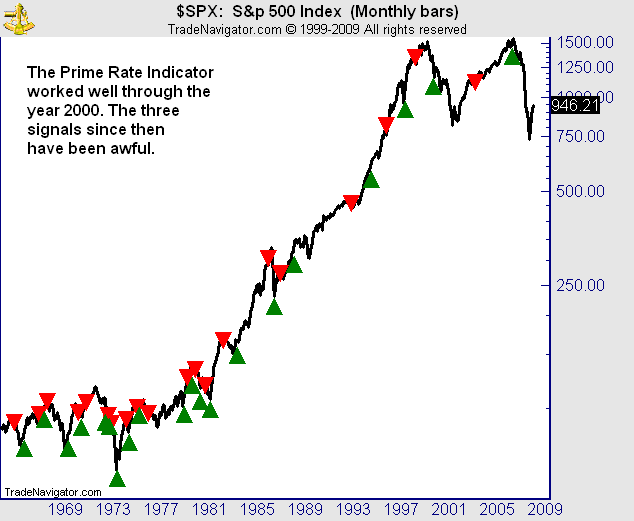The Prime Rate Indicator may have passed its prime
“The trend in interest rates and Federal Reserve policy is the dominant factor in determining the stock market’s major direction” according to Martin Zweig in Winning on Wall Street. In telling his readers how to get in and out of the stock market at optimal moments, Zweig began with the Prime Rate Indicator.
The Prime Rate is the rate at which banks lend money to their most-favored customers. Zweig observed that changes in the Prime Rate coincided with changes in the trend of the stock market. He created the Prime Rate Indicator by defining buy and sell rules based upon the direction and size of changes in the Prime Rate. An investment of $10,000 based upon the Prime Rate Indicator in the 42 year period from 1954 through 1996 would have increased by a compound annual growth rate of 11.58 percent to $996,909.00.

Prime Rate Indicator Buy and Sell Signals
The performance of the Prime Rate Indicator since 2001 has not matched the performance of previous years. The last three signals have been spectacularly bad. The approach produced a buy signal on February 1, 2001 and then the S&P 500 fell 42 percent. The approach produced a sell signal on August 11, 2004 and then stocks rallied 41 percent. The most recent signal from the Prime Rate Indicator was a buy signal on September 18, 2007. The S&P 500 achieved an all-time high three weeks later and then fell by 50 percent.
Maybe the financial arena has changed in fundamental ways and the Prime Rate Indicator no longer works. Or maybe the Prime Rate Indicator has never “worked.”
The Prime Rate Indicator assumes that interest rates are important to the trend of the stock market, but maybe that’s not how things work. Maybe the trend of the stock market determines the direction and size of interest rate changes.
The chart of the S&P 500 with Prime Rate Indicator Buy and Sell Signals shows that after the stock market has been rising for a while, interest rates typically rise and produce a sell signal. And after the stock market has been falling for a while interest rates typically fall and produce a buy signal. Conventional wisdom says that it is the rise of interest rates that stops the stock market from rising, but maybe it is the rise of the stock market that forces interest rates up and the fall of the stock market that forces interest rates down.
The last three signals of the “Prime Rate Indicator” actually make sense if stock market moves are the dominant factor in determining the major direction of interest rates. The buy signal of February 2001 developed after the stock market had fallen sharply. In this case, the fall wasn’t finished yet and the buy signal preceded stocks bottoming by 20 months. Similarly, the sell signal of August 2004 developed after the stock market had risen sharply, but the advance still had a long way to go. The last buy signal developed after the Value Line Composite Index and a variety of global stock indexes had fallen for two months.
Regardless of which comes first, the stock market move or the interest rate change, the Prime Rate Indicator has not marked stock market turns accurately for a long time and should probably not be used as a primary timing approach. The Buy and Sell Signals from the Prime Rate Indicator may best be used to strengthen or weaken confidence in investment decisions based upon other approaches to stock market timing.
Click here to see documentation of Prime Rate Indicator Buy and Sell Signals since 1947.
 Financial markets are predictable because segments of price action fit together in a limited number of patterns that are not random. Markets are unpredictable too because there is enough variability in the patterns to hide the trend at some stages of development. I am fascinated by the market and spend a lot of time working to identify price trends so I can exploit them for profit.
Financial markets are predictable because segments of price action fit together in a limited number of patterns that are not random. Markets are unpredictable too because there is enough variability in the patterns to hide the trend at some stages of development. I am fascinated by the market and spend a lot of time working to identify price trends so I can exploit them for profit.